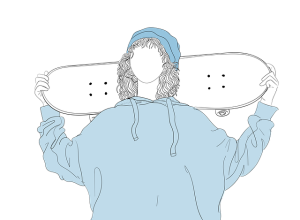Choosing the right longboard as a beginner is crucial for an enjoyable and progressive experience. A suitable longboard should have a flexible deck, reliable trucks, adaptable wheels for different terrains, high-quality bearings, and premium grip tape to ensure safety and control. Beginners must also consider essential gear like a helmet, protective padding, and appropriate footwear for optimal stability. Accessories such as traction pads, carry straps, and reflective clothing or lights enhance both safety and comfort, especially when riding at night. Maintaining your bearings with regular cleaning and lubrication will keep them running smoothly. By carefully selecting and personalizing their gear, beginners can maximize their longboarding enjoyment and skill development, whether they're cruising city streets or exploring off-road trails.
Embarking on a longboarding journey offers an array of style options tailored to every beginner’s preferences and needs. This comprehensive guide delves into the distinctive advantages of longboards, illuminating why they stand out as an excellent choice for newcomers to the sport. From deciphering the anatomy of a longboard to selecting the perfect deck dimensions and shapes, understanding wheel types and hardness, and grasping the mechanics of trucks and bushings, this article equips you with essential knowledge to navigate your longboarding adventure confidently. Additionally, insights into bearing selection and maintenance, the role of grip tape, and footstrap options ensure you prioritize safety and performance from your very first ride. Accessorizing your longboard with straps, helmets, and other vital gear will not only enhance your comfort but also protect you as you progress. Join us as we explore the diverse style options available for beginners in the world of longboarding.
Understanding Longboards: A Beginner's Guide to Their Distinctive Advantages

Longboarding presents a unique and exhilarating riding experience compared to traditional skateboards, and for beginners looking to explore this diverse style option, understanding the distinctive advantages of longboards can be quite enlightening. Longboards are typically characterized by their larger decks, longer wheelbases, and larger wheels, which offer a more stable ride, making them particularly suitable for newcomers. The increased stability allows for a smoother learning curve, reducing the likelihood of falls and enhancing the rider’s confidence as they get accustomed to the feeling of gliding on two wheels.
Moreover, longboards are designed with various disciplines in mind, such as downhill racing, cruising, freestyle, and dancing. Each discipline offers its own set of advantages: from the speed and control afforded by downhill models to the maneuverability and balance focused on in freestyle and dance longboards. For those just starting out, a longboard for beginners often comes with softer wheels that provide better shock absorption over rough terrain, making it easier to handle bumps and uneven surfaces. The longer wheelbase also contributes to a smoother ride, allowing the board to glide over obstacles rather than getting hung up on them. This not only makes longboards an excellent choice for beginners but also opens up a world of possibilities for exploration and personal progression in the world of longboarding.
The Anatomy of a Longboard: Key Components and What They Mean for New Riders

When embarking on the journey of longboarding, understanding the anatomy of a longboard tailored for beginners is crucial. A longboard, as opposed to a standard skateboard, is designed for greater stability and speed, making it ideal for newcomers to the sport. The deck, which is the foot platform, tends to be longer than that of a skateboard, providing a more spacious and comfortable area for riders’ feet. For beginners, this extra length aids in balance and offers a wider range of movement for various tricks and turns as skill levels advance.
The trucks, which are the pivoting points where the deck meets the wheels, are typically wider on a longboard. This design feature enhances stability, allowing new riders to navigate with confidence. The wheels, ranging from 60mm to 80mm in size for beginners’ boards, are softer and provide a smoother ride over different terrains. The bushings, which are rubber rings around the trucks, can be adjusted to fine-tune the flex of the board, thus influencing the responsiveness and turning ability. For those just starting out, it’s advisable to opt for a longboard with a lower degree of wheel hardness (durable material measure) like 78a or 80a, as this will offer better grip and control on various surfaces. Additionally, bearings, which allow the wheels to rotate smoothly, are an essential component that contributes to the overall performance and responsiveness of the board. A high-quality set of ABEC (Annular Bearing Engineering Committee) rated bearings is a must for beginners looking to enhance their longboarding experience. Understanding these key components will empower new riders to make informed decisions when selecting a longboard that suits their needs, ensuring a safe and enjoyable entry into the world of longboarding.
Deck Dimensions and Shapes: Finding the Right Fit for Your First Longboard

When embarking on your longboarding journey as a beginner, selecting a deck that fits both your stature and riding style is paramount. Deck dimensions and shapes play a significant role in your overall experience, from stability to maneuverability. A typical longboard for beginners measures between 33 to 42 inches, providing ample space for comfortable foot placement and room for growth as your skills evolve. The width of the deck should be at least 9 inches to offer a stable platform, especially when transitioning from a skateboard or if you have larger feet.
Moreover, the shape of the longboard deck can influence the type of riding you’ll be doing. A pintail or minitail is ideal for cruising and downhill racing, offering a sleek design with a cutout at the end to improve leverage when carving. Drop-through mounting is often recommended for beginners as it lowers the center of gravity, making the board more stable and easier to push. Alternatively, a drop deck or double drop can provide an even lower ride, which is great for freeriding but may require some getting used to for those new to longboarding. It’s important to consider the various shapes and mounting options available, as they will significantly affect your riding experience and learning curve as a beginner.
Wheel Types and Hardness: Navigating the Options for Different Terrains and Styles

When embarking on a journey through various terrains, the choice of wheel type and hardness plays a pivotal role in ensuring a smooth and enjoyable ride. For beginners exploring different landscapes on a longboard, the selection process can be both intriguing and crucial. Soft wheels, typically ranging from 78a to 85a on the durometer scale, offer superior grip and are ideal for technical riding or wet conditions, making them a popular choice for those new to longboarding. They perform well on smooth surfaces like streets or skate parks, allowing for easier carving and turning. On the other hand, harder wheels, ranging from 90a to 101a, excel on rougher surfaces such as gravel or cracked pavement. These wheels offer less grip but more speed and a smoother ride over imperfections due to their larger contact patch. For beginners, a medium-hardness wheel, around 82a to 87a, often strikes the perfect balance between control and versatility, accommodating various terrains from city streets to smooth dirt trails. When selecting wheels for your longboard, consider factors like the terrain you’ll be traversing, your riding style, and personal preference to ensure an optimal experience on four wheels.
Trucks and Bushings: The Mechanics Behind a Smooth Ride on a Longboard

When exploring the world of longboarding, a key aspect to consider for beginners is the mechanism that ensures a smooth and stable ride. At the heart of this experience are trucks and bushings, crucial components that play a pivotal role in the board’s responsiveness and performance. Trucks, specifically designed for longboards, are the metal hinges that pivot and allow the board to turn or carve. They come in various widths and sizes, catering to different riding styles and preferences. For beginners, a mid-sized truck often provides an optimal balance between stability and maneuverability.
Equally important to the trucks are the bushings, which act as vital suspension elements. These rubber or plastic pieces fit snugly into the trucks and absorb shock, reducing the vibrations from rough terrain that can disrupt your ride. They come in different durometers (hardness levels), with softer bushings offering more flex for a smoother ride over uneven surfaces, while firmer bushings provide more stability at higher speeds. Beginners should experiment with different bushing sets to find the perfect combination that suits their weight and riding style. This fine-tuning process allows them to enjoy a seamless glide on their longboard, whether they’re cruising city streets or carving through a scenic trail. Understanding how trucks and bushings work together is essential for any beginner looking to maximize the comfort and efficiency of their longboarding experience.
Bearing Selection and Maintenance: Keeping Your Longboard Rolling Smoothly

When it comes to selecting bearings for your longboard, especially as a beginner, it’s crucial to consider the quality and type that will suit your riding style and preferences. High-quality bearings are pivotal in ensuring a smooth ride, as they reduce friction and allow for faster, more responsive movement. ABEC (Annular Bearing Engineering Committee) ratings can guide you in choosing bearings with precision and durability. Typically, ABEC 3, 5, or 7 rated bearings are recommended for longboards due to their ability to handle the force and speed generated while riding. Additionally, bearings designed specifically for downhill or freeriding may offer superior performance and longevity compared to general-purpose bearings.
Maintaining your longboard’s bearings is equally important to preserve their optimal functioning. Regular maintenance involves cleaning the bearings with a appropriate solvent, like methanol or acetone, after each ride to remove dirt and debris that can cause resistance and wear them out over time. Lubrication is also key; applying a thin layer of lubricant, such as ABEC Lubri-Film, can help keep the bearings running smoothly and protect against corrosion. Remember to spin your wheels after maintenance to ensure even lubrication and to check for any damage or wear that might affect performance. By selecting the right bearings for your longboarding needs and maintaining them properly, you’ll be able to enjoy a consistently smooth ride, whether you’re carving through urban streets or cruising downhill trails.
Grip Tape: The Unsung Hero of Longboarding Safety and Performance

Grip tape, a critical component often overlooked by novice longboarders, plays a pivotal role in both the safety and performance of your longboarding experience. This fine sandpaper-like material adheres to the top of the board, providing riders with much-needed traction against their shoes. This traction is crucial for foot placement during turns and maneuvers, allowing beginners to navigate the board confidently and safely. The subtle texture not only prevents slips but also absorbs some of the impact from vibrations and bumps encountered on the road, enhancing the overall riding comfort. Selecting a longboard for beginners that comes with high-quality grip tape is essential for mastering the basics and progressing to more advanced techniques. Properly maintained grip tape can extend the longevity of your board by protecting it from wear and tear that would otherwise compromise its integrity. As you advance in longboarding, the importance of grip tape becomes even more apparent, as it allows for precision foot placements during intricate tricks and longer rides. For beginners, a longboard equipped with quality grip tape can be the difference between an enjoyable hobby and a potentially hazardous experience. It’s a small detail that makes a significant difference in both the safety and enjoyment of longboarding.
Footstrap Options: Enhancing Control and Comfort for Beginner Longboarders

For those embarking on their longboarding journey, selecting the right footstrap options is pivotal in both enhancing control and ensuring comfort. A longboard for beginners should come equipped with adjustable straps that cater to various foot sizes, providing a snug yet not overly tight fit. The strap design itself varies; some favor open-toe designs that offer better pedal feel, while others prefer a more enclosed fit for added security. Beginners will appreciate models featuring easy-to-use buckles and velcro closures that allow for quick and hassle-free adjustments on the fly. The quality of the material in the straps is equally important; high-grade, breathable fabrics can prevent chafing and blisters during extended rides, which are common concerns among novices. Additionally, the footstraps should be designed to minimize the risk of toe drag, a common issue that can impede the learning process. By selecting a longboard for beginners with thoughtfully designed footstraps, newcomers can confidently navigate their path to mastering the sport, all while enjoying the ride with greater stability and comfort. It’s advisable to experiment with different strap setups to find what best suits your foot shape and riding style, as this personalization can significantly impact the overall experience on the board.
Accessorizing Your Longboard: Straps, Helmets, and Other Essential Gear for Safe Riding

When venturing into the world of longboarding, selecting the right gear is paramount to ensure both safety and optimal performance. For beginners, a durable longboard that fits their skill level is the foundation of their riding experience. However, beyond the board itself, accessories play a crucial role in complementing your ride. A high-quality helmet is an essential piece of equipment, protecting your head from potential impacts during falls or collisions. Straps are another vital component; they not only secure your feet to the board for better control but also prevent them from slipping off during aggressive rides or on slippery surfaces. Additionally, protective gear such as knee pads, elbow pads, and wrist guards can significantly reduce the risk of injury by cushioning your falls and absorbing impacts.
Investing in a comfortable pair of shoes with grip is also important, as they will connect you directly to the board and influence your stability and balance. Reflective gear or lights are highly recommended for those who ride during low-light conditions, enhancing visibility and ensuring safety on roadways. Grippy traction pads on the deck of your longboard can provide additional foot grip, especially when maneuvering at speed or in wet conditions. Lastly, consider adding a carry strap or bag to transport your longboard conveniently and safely. With the right combination of these accessories, beginners can embark on their longboarding journey with confidence, knowing they are well-equipped for a wide range of riding scenarios.
